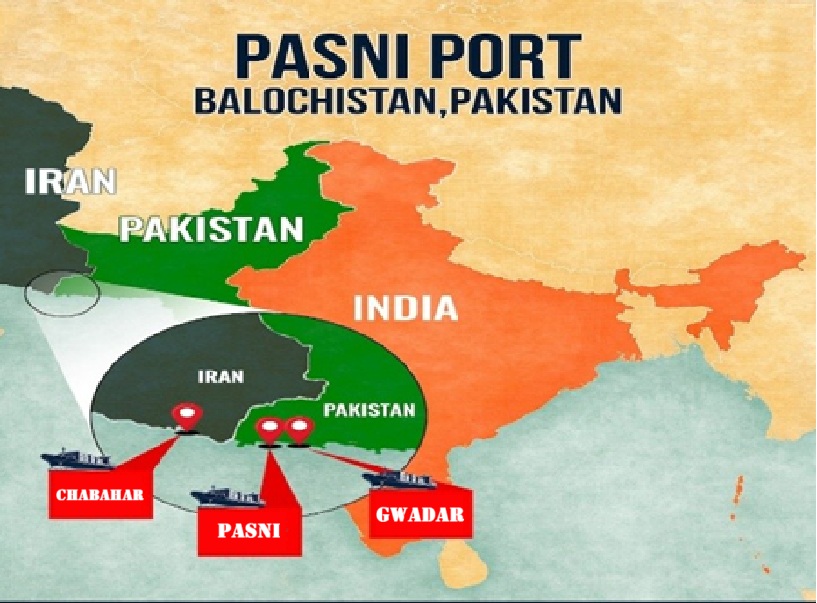
- Located about 100 miles from Iran and 70 miles from the Chinese-run Gwadar port, Pasni is envisioned as a transport hub linking the mineral-rich Reko Diq region to global markets.
- Geographically, Pasni sits at a crucial junction bordering the Arabian Sea, Iran, India, and Central Asia, offering the U.S. both military and economic reach into key maritime zones and the ability to keep a closer watch on Iran and China.
- For India, a U.S. presence in Pasni, just 100 miles from Iran, could significantly affect its strategic and economic interests.
- By inviting competing powers into its territory, Pakistan risks becoming a geopolitical battleground rather than reaping long-term national gains.
Pakistan has proposed that the United States build and operate a strategic port at Pasni, a small town on its southern coast, seeking $1.2 billion in U.S. investment. The proposal was made by Pakistan’s Field Marshal and Prime Minister Shehbaz Sharif during their recent U.S. visit, though Washington has yet to respond officially.
Located about 100 miles from Iran and 70 miles from the Chinese-run Gwadar port, Pasni is envisioned as a transport hub linking the mineral-rich Reko Diq region to global markets. Pakistan showcased its critical minerals—especially copper and antimony—to President Trump, aligning with his push to secure strategic resources and counter China’s influence. Islamabad hopes U.S. investment will boost its industrial output, currently only 3% of GDP.
The offer follows a turbulent phase in U.S.–Pakistan ties, marked by the Pahalgam terror attack and subsequent Indian air strikes that damaged Pakistani sites housing U.S. equipment. Pakistan has since moved to deepen ties with Washington, with Trump making favourable remarks toward Islamabad and receiving support from Shehbaz Sharif, including a Nobel Prize nomination. Pakistan has also sought to raise its diplomatic profile by aligning with Arab states on the Palestine issue and engaging Trump at the UN on a ceasefire.
Strategic Gains for Washington
For Washington, Pakistan’s Pasni proposal holds clear strategic appeal. Access to Pakistan’s copper and rare minerals would strengthen U.S. competitiveness in the semiconductor and critical minerals race against China. Geographically, Pasni sits at a crucial junction bordering the Arabian Sea, Iran, India, and Central Asia—offering the U.S. both military and economic reach into key maritime zones and the ability to keep a closer watch on Iran and China.
Historically, Pakistan has provided geographic leverage to the U.S., especially during the Afghan war. With growing American interest in Iran after the Afghanistan withdrawal, a presence in southern Pakistan gains added value.
The project would also allow Washington to counter China’s expanding influence in the region. Gwadar, a major node in China’s Belt and Road Initiative, lies just 70 miles from Pasni. A U.S.-run port there would directly challenge Beijing’s strategic foothold in South Asia and the Arabian Sea.
Additionally, control over Pasni would help the U.S. retain regional influence near Afghanistan and Central Asia. President Trump’s recent comments on reclaiming Bagram Air Base from the Taliban, though legally baseless, underline his administration’s aggressive push to sustain geopolitical leverage in the region.

Geopolitical Implications for India
For India, a U.S. presence in Pasni—just 100 miles from Iran—could significantly affect its strategic and economic interests. India has heavily invested in Iran’s Chabahar port, a key link for trade with Central Asia under the International North-South Transport Corridor (INSTC). Washington’s recent move to reintroduce snapback sanctions on Iran adds further risk, potentially complicating India’s trade and connectivity plans.
American proximity to Iran and India’s trade routes, coupled with closer U.S.–Pakistan ties, creates an unfavourable geopolitical environment for New Delhi. For Pakistan, this partnership boosts military and economic support against India; for the U.S., it serves as a strategic signal to India to align more closely with American interests.
The emerging U.S.–Pakistan–Arab nexus, backed by Washington through support for Saudi–Pakistan defence cooperation, points to a broader attempt to increase U.S. influence in South Asia and the Islamic world. This alignment could strategically isolate India. However, India under Prime Minister Modi has responded with a firm, interest-driven foreign policy, resisting these pressures.
China and Regional Implications
China, which has poured billions into Pakistan through CPEC and Gwadar Port, will view a U.S. presence in Pasni with unease. Washington’s entry gives it strategic visibility and economic reach in a region China considers central to its interests. Beijing knows the U.S. aims to dilute Chinese influence not just in Pakistan, but across the Arabian Sea and South Asia.
For Pakistan, balancing between the two rival powers will be difficult. Both wield economic and military clout, and trying to accommodate both could create internal contradictions and instability. By inviting competing powers into its territory, Pakistan risks becoming a geopolitical battleground rather than reaping long-term national gains.
Local resentment could grow as well, with U.S. involvement potentially fuelling unrest in volatile Balochistan. The troubled CPEC experience underscores the risks: despite heavy investment, corruption, governance failures, and security threats have stalled progress, leaving projects incomplete and benefits unrealised. For the U.S., this serves as a warning that large-scale investments in Pakistan could turn into strategic and financial liabilities.
Conclusion
Ultimately, Pakistan’s bet on transforming its southern regions into a mineral investment hub may backfire. Rather than stabilising the economy, it could trigger greater insecurity and unrest, particularly in Balochistan. Meanwhile, for Washington, this proposal, though strategically tempting, could turn into another costly geopolitical gamble if not handled with prudence.
Aayush Pal is a freelance writer on contemporary geopolitical developments. The views expressed in his work are entirely his own.
